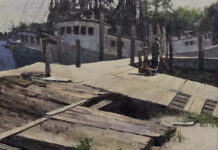
This ongoing feature will showcase websites that artists have found useful. This week we examine the “Artists Helping Artists” blog.

Leslie Saeta, the artist behind the blog
The blog is the work of Leslie Saeta, a palette-knife painter from Pasadena, California. The website has information on her and her workshops and artwork, but primarily it consists of online talk radio for artists. With her blog, she has found a way to share what she’s learned from other artists, have guests who serve as experts on specific topics, and promote her own career, all in one package. It’s a good idea, and one that Saeta has executed well enough to develop a following.

“A Beautiful Day,” by Leslie Saeta, oil, 12 x 12 in. Private collection
Topics currently posted on the blog include “The Twenty Most Important Things to Know About Color,” “Selling Your Art Through Interior Designers,” “The Best Ways to Advertise Your Art … With or Without a Budget,” and “Are Plein Air Competitions for You?” The topics seem to have grown organically out of her own research and development as an artist, and Saeta is generous and smart enough to know that having an expert join her on these audio recordings adds additional credibility and excitement.
The blog and the audio recordings are free.





A very interesting and informative piece! I’ve not heard of this place before and it prompts me to wonder how many others like it exist throughout the country. Thanks for reporting on both the event and the locale.
The only other artist’s home and studio designated as a National Historic Site is Daniel Chester French’s place, “Chesterdale” in Stockbridge, Massachusetts.
I was interested to read how much the landscape around the farm has changed since Weir’s day.
That is a problem with so many of the sites in New England where the great 19th century painters worked- farming and lumbering were widespread in those days allowing many panoramic views. Now the forestes have re-grown and those open views are lost to us today. This is another example of how paintings are usually specific to the era that produced them, sometimes more than we’d like.
There are of course great New England panoramas for painters, but we have to look a lot longer and harder to find these locations. One thing that can help is if you can find a local plein air painter who knows the terrain well. I was just up in the Lake Placid area painting- as luck would have it the woman at the desk at the motel where I was staying turned out to be just such a painter. She drew me a map of the “good” locations that proved to be a gold mine.